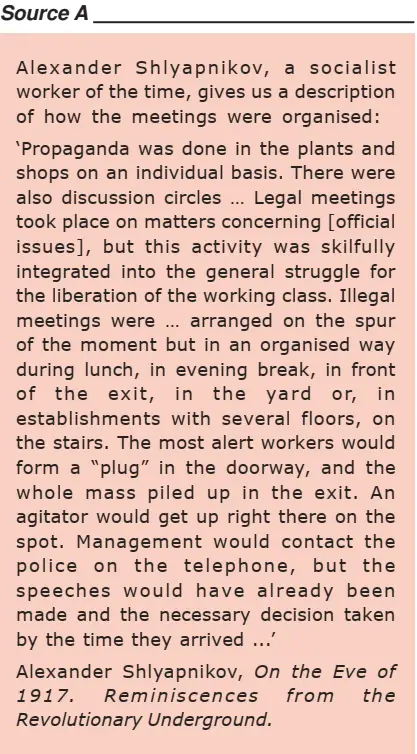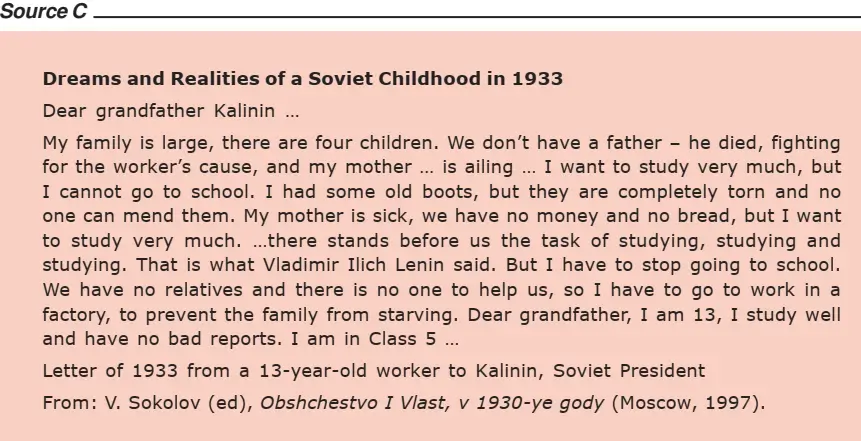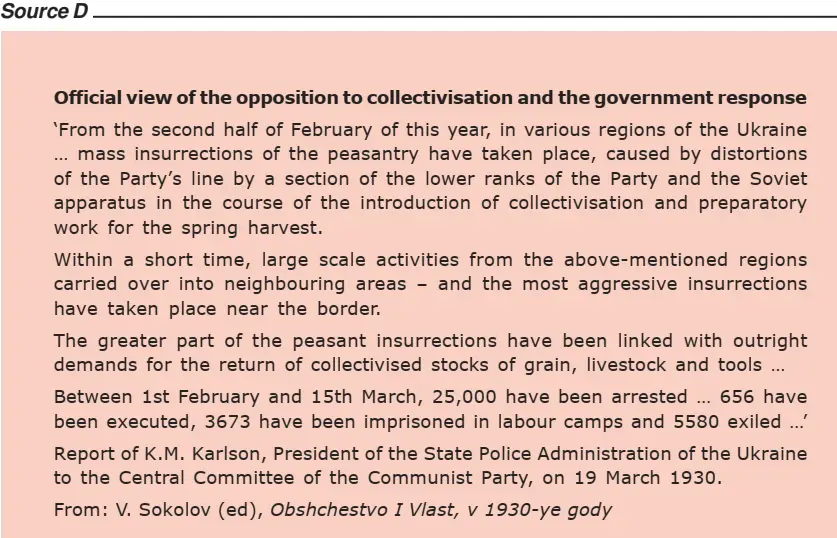NCERT Solution for Class 9 History Chapter 2 Socialism in Europe and the Russian Revolution
Intext - Questions
Activity 1
Question.1. List two differences between the capitalist and socialist ideas of private property.
Ans. The two differences are as follows:
- The capitalists believed that individuals owned private property whereas the socialists believed that all property belonged to the society as a whole, i.e., to the state.
- The capitalists believed that the profits from the property should belong to the property’s owners, whereas the socialist believed that profits are due to the workers’ labor and so should be shared by them.
Activity 2
Question.1. Imagine that a meeting has been called in your area to discuss the socialist idea of doing away with private property and introducing collective ownership. Write the speech you would make at the meeting if you are:
- A poor laborer working in the fields
- A medium-level landowner
- A house owner
Ans. Respective Sample speeches are given below:
- A Poor Laborer working in the Fields: Dear friends, nature has not done any partiality in providing resources to everyone and so some people owning more land than others is incorrect. All the profits from our crops are the result of hard work done by people like me in planting seeds, watering the crops, keeping them free from weeds and harvesting them. So, I think we laborers should share in the profits made from sale of crops, instead of getting a subsistence wage. To enable this, private ownership of property needs to be abolished and collective ownership of the fields by all the laborers who are working on it introduced.
- A Medium-Level Land-owner: Respected friends, I do not agree that private ownership of property should be removed. It is not rational and will reduce the crop production. You will not try to increase crop production if the whole profit is not going to you. In fact, what should be done is the equitable distribution of land to all, so that only some people do not own large tracts of land, while others have to manage with small areas of land, or are deprived completely of any land ownership. So, all should be landowners so that everybody benefits.
- A House Owner: Friends, I think everybody should have the basic necessities of life like food, shelter and clothing, but not at the expense of other people’s property. Those who do not have land should be given the means to earn their livelihoods in whatever manner is convenient. We have earned our property through the sincere efforts of our ancestors and so we should not be deprived of the labor and wisdom of our forefathers in acquiring land. I think this is very reasonable.
Activity 3
Question.1. Why were there revolutionary disturbances in Russia in 1905? What were the demands of revolutionaries?
Ans.
- The causes of the revolutionary disturbances in Russia in 1905 were:
- Due to Russia’s defeat in the Russo-Japanese War in 1904, prices of essential goods rose dramatically, so that real wages declined by 20 per cent.
- At the Putilov Iron Works, dismissal of some workers caused a strike.During the subsequent events, a procession of workers was attacked by police in which 100 workers died. This was known as Bloody Sunday.
- Subsequently, strikes took place all over the country, resulting in the creation of an elected Parliament or Duma.
- The revolutionaries demanded a reduction in daily working hours to eight, increase in wages and improvement in working conditions.
Activity 4
Question.1. The year is 1916. You are a general in the Tsar’s army on the eastern front. You are writing a report for the government in Moscow. In your report suggest what you think the government should do to improve the situation.
Ans. In the years 1914-1916, Russia had lost to Austria and Germany and Austria in the eastern front WWI, and had over seven million fatalities by the year 1917. As Russia retreated, the army destroyed buildings and crops to stop the enemy from living off the land. The destruction of buildings and crops resulted in more than three million refugees in Russia.
This situation disgraced the Tsar and the government. The war also impacted industry. By 1916, railway lines broke down there were labor scarcities, small workshops manufacturing essentials went out of business, large grain supplies were sent to feed the army, four and bread became scarce, and there were rampages at bread shops.
The Russian militia had a lot of problems as stated above, on the Eastern Front WWI; however the most conspicuous problem was related to logistics. Most of the Russian soldiers who were fighting the battle were poorly trained and poorly equipped. Russia had lost to Austria and Germany and Austria in the eastern front WWI, and had over seven million fatalities by the year 1917.
If I was a general who had the position to criticize the govt. and bring about change, I would ask for better and improved rail lines, since majority of Russia’s supply problems were owing to not utilizing uniform rail gauges, and by bringing better rail line would help in transporting more food and essentials to the Russian troops and these better conditions would enhance non-combatant fatalities and reduce desertion rates.
Furthermore, I would encourage better cooperation and coordination amongst generals, since key battles in the eastern front WWI such as Tannenburg were lost owing to generals working, competing with each other rather than in cooperation with each other.
Activity 5
Question.1. Look again at Source A and Box 1.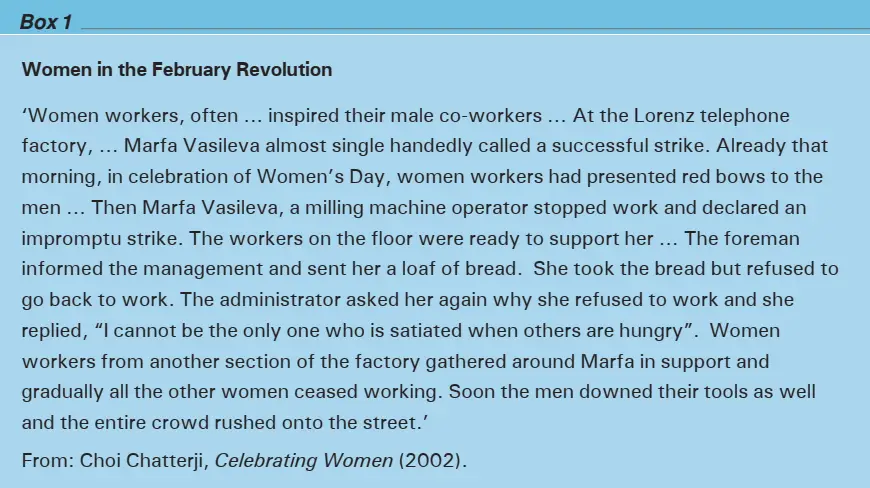
Place yourself in the position of a woman who has seen both situations and write an account of what has changed.
alexander women revolution
Ans. (A) List five changes in the mood of the workers.
The changes in the mood of the workers were:
- Earlier only meetings were being held in an organized manner. Now the workers just stopped work to press for their rights, like Marfa Vasileva did.
- Earlier there is no mention of any women workers. But now a woman worker initiated the strike by stopping work.
- Earlier there was no demonstration of unity between men and women workers. Now the women presented red bows to the men, showing the unity. Also, the men downed tools in support of the women who had gone on strike.
- The mood of the workers was more determined now. They took action instead of just talking.
- Earlier work used to go on due to workers being afraid of some counter action from the management side, but now the work was stopped, showing the fearlessness of the workmen.
(B) Place yourself in the position of a woman who has seen both situations and write an account of what has changed.
- I have seen both situations and I feel that although earlier the workers gave vent to their problems by organizing meetings only, now they are fearless, willing to sacrifice their job, rebellious and supporting each other’s action as well as cutting across gender differences.
Activity 6
Question.1. Read the two views on the revolution in the countryside. Imagine yourself to be a witness to the events. Write a short account from the standpoint of:
- an owner of an estate
- a small peasant
- a journalist
Ans. Sample accounts of the revolution are given below:
- An Owner of an Estate: My property was taken over by my farm laborers. They spared me and my family, but now I am totally dependent on their mercy. They are not telling me anything about whether my property will be returned to me in the future or not.
- A Small Peasant: I am happy that together all of us laborers on this farm have taken it over and can now earn more by sharing the profits from the sale of the grain produced by us. Earlier the profits were all taken by the landowner without him doing any work. I salute the revolution, which has made our lives better.
- A Journalist: The news of the uprising has been welcomed in the rural areas by the peasants overpowering the landowners and taking over the running of the farms jointly. The orchards have been divided among the peasants who worked on them earlier, so that they can enjoy the profits from them. Surely the revolution has ushered in prosperity for the common man at the expense of the landowners.
Activity 7
Question.1. Why did people in Central Asia respond to the Russian Revolution in different ways?
Ans. The people in Central Asia responded enthusiastically to the February 1917, Revolution because it freed them from the oppression of the Tsar’s reign so that they were masters of their land again. They expected to regain their autonomy. However, they responded negatively to the October Revolution, as it brought violence, pillage, extra taxes and another dictatorial power to rule over them. They feared now that their autonomy would be lost.
Activity 8
Question.1. Compare the passages written by Shaukat Usmani and Rabindranath Tagore. Read them in relation to Sources C, D and E.
- What did Indians find impressive about the U.S.S.R.?
- What did the writers fail to notice?
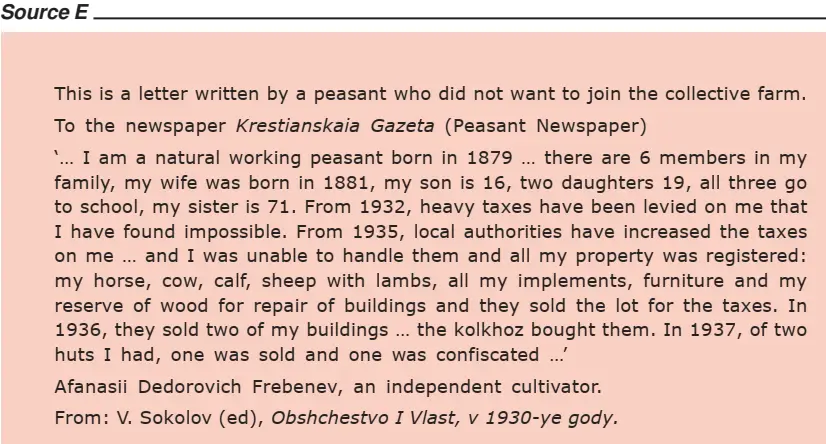
- What did Indians find impressive about the USSR?
At the time when both wrote these passages, India was ruled with an iron hand by the British. There were vast caste and class differences and the people were ignorant and backward. They were impressed by the fact that all persons in Russia were treated equally. In spite of them not being very prosperous, they were happily going about their work. Asians and Europeans mingled freely in Russia, whereas it was unthinkable in India at that time. - What did the writers fail to notice?
What the two writers failed to notice was that essentially the people were not free to do as they liked. The Bolsheviks ruled like dictators and followed repressive police to develop the nation quickly. The hard lives and poor working conditions of the people went unnoticed by these travelers.
Activity 9
Question.1. Imagine that you are a striking worker in 1905 who is being tried in court for your act of rebellion. Draft the speech you would make in your defence. Act out your speech for your class.
Ans. Your honor and respected citizens, I have not committed any crime, although I am being tried for inciting rebellion. You know how the price of bread has gone up. My wages accordingly should have been increased so that my family does not starve. Now-a -days, we only eat one meal in a day, as there is no money to buy more food. So what is wrong if I demand increase in wages?
- I am forced to work 12 hours a day, which is inhuman. I have demanded an eight hour working day, which is quite reasonable.
- Have I committed a crime in that? Now I leave it in your hand to decide whether I am a criminal or not.
Question.2. Write the headline and a short news item about the uprising of 24 October 1917 for each of the following newspapers
- a Conservative paper in France
- a Radical newspaper in Britain
- a Bolshevik newspaper in Russia
Ans.
- Conservative Newspaper in France:
The Socialist Terror in Russia Supporters of Bolshevik have caused ruckus in Russia. The military troops have seized the government offices in a bid to overthrow the Provisional Government. These disturbing Events mark a Black day in the history of Russia and is widely condemned. - Radical Newspaper in Britain:
The Socialist Sun Rises in Russia .The morning of 24th October was a morning of bliss and wonder in Russia.The rise of Bolsheviks against the oppressive Provisional Government is the welcomed cry of support for more modern ideas and practices that the world currently needs.This day is a mark of glorious victory for Socialists, not just in Russia, but all around the world. - A Bolsheviknews paper in Russia:
We Rise and We Win this day is a remarkable day for the Russians as we finally made the much awaited move against the preposterous Provisional Government.We overthrew the biased officials in all government offices and promise to establish a more people-centric socialist government.
Question.3. Imagine that you are a middle-level wheat farmer in Russia after collectivization. You have decided to write a letter to Stalin explaining your objections to collectivization. What would you write about the conditions of your life? What do you think would be Stalin’s response to such a farmer?
Ans.
Respected Stalin,
I am Gayathri and I am a farmer in morocco. I am a middle level Russian wheat farmer. I’m writing this letter to say something extremely important to you. The collectivization policy which has been implemented to transform the traditional agricultural practices has been a boon to some but a bane to many. Due to this prosperous peasants have been forced to give up their lands and join the large collective farms. The lands which we owned and looked after for years are now not under our control. In addition to this, we are also facing the problem of rapid industrialization. Collectivization is considered to be desirable and socialistic to some. But the actual scenario here is only known to us. As a result of collectivization, many leaders are forcing us to produce more crops using modern machinery and are selling our crops in low costs. we are feeling very reluctant to abandon our individual farms. Kindly understand our situation and do the needful.
Stalin’sresponse :
Dear Gayathri,
I understand your plight and I will definitely help you all to get you out of this situation.
Exercise
Question.1. What were the Social, Economic, and Political conditions in Russia before 1905?
Ans. The social, economic and political conditions in Russia, before 1905 were quite backward. Social inequality was very prominent among the working class. Workers were divided on the basis of their occupation. Workers whose jobs needed skill and training considered themselves on a higher plane than the untrained worker. Workers had strong links to the villages they came from and this also caused a social divide among workers.
Economically Russia was going through a very difficult period. The population had doubled and the economic conditions turned from bad to worse. The government introduced new programs of industrialization which created employment. This Industrialization did not help the workers who were exploited and their living conditions only worsened.
Compared to other European nations, Russia was politically backward, during the thirteenth century. All political parties were illegal in Russia before 1914. The Russian peasants formed the Socialist Revolutionary Party in 1900, but as they were not a united group they were not considered to be part of a socialist movement.
Question.2. In what ways was the working population in Russia different from other countries in Europe, before 1917?
Ans. The working population in Russia was different from that of those in other countries in Europe before 1917 in the following ways.
- The vast majority of Russians were agriculturalists. This proportion was higher than in most European countries. In France and Germany, this proportion was between 40% and 50%.
- The cultivators in Russia produced for the markets as well as for their own needs.
- Workers were divided social groups on the basis of skill. Metalworkers considered themselves aristocrats among other workers as their occupation demanded more training and skills.
- Peasants in Russia had no respect for the nobility. Nobles got their power and position through the Tsar and not through local popularity, whereas in countries like France, peasants respected nobles.
- In Russia, peasants had pooled their land together and divided the profits according to the family needs. In other parts of the world, agriculture was done individually by the peasants.
Question.3. Why did the Tsarist autocracy in Russia collapse in 1917?
Ans. During the winter of 1917, factory workers faced acute food shortages and extreme cold climate. Dissatisfaction was raging high among the workers.
A factory lockout on the right bank of the river Neva, triggered a strike in the month of February, 1917. 50 other factories joined in the strike. In many factories women led the strike. The government tried many measures to contain the strike. Curfew was Imposed the cavalry and police were called out to suppress the workers. The Dissatisfied worker could not be contained. On the 27th of February, the Police Head Quarters’ were ransacked. The turning point of this revolt was when the government regiments joined the striking workers. They formed the ‘Soviet’ or ‘Council’. The Tsar was advised to abdicate. Thus the February Revolution brought down the monarchy in 1917.
Question.4. Make two lists: one with the main events and effects of the February Revolution and the other with the main events and effects of the October Revolution. Write a paragraph on who was involved in each, who were the leaders and what the impact of each was on Soviet history.
Ans.
Events |
|
Effects |
|
No political party was involved in the February Revolution. It was a combined effort of the workers of fifty factories along with women who took up the leadership.
October Revolution:
Events |
|
Effects |
|
Lenin led the October Revolution along with Leon Trotskii. Bolshevik supporters in army, Soviets and factories were mobilized for mass struggle. Lenin rose to power and set up a Bolshevik government in Soviet Russia.
Question.5. What were the main changes brought about by the Bolsheviks immediately after the October Revolution?
Ans.
- Banks and Industries were nationalized.
- Land was declared as social property.
- Peasants seized land from the nobility.
- Large houses were partitioned according to family requirements.
- The use of old titles by aristocrats was banned.
- New uniforms were introduced for the army and officials. The famous soviet hat (budeonovka) was introduced.
Question.6. Write a few lines to show what you know about:
- Kulaks
- the Duma
- women workers between 1900 and 1930
- the Liberals
- Stalin’s collectivisation programme
Ans.
- Kulaks: Well-to-do peasants were called‘kulaks’ during Stalin’s leadership. As food shortage continued Stalin decided to introduce the Collectivization Program. Under this program, ‘kulaks’ were eliminated. That is land from these well-to-do peasants was forcibly taken and large state-controlled farms were established. This was done to modernize farming and increase production.
- The Duma: The Duma is an elected consultative Parliament, which was set up during the 1905 Revolution. Though the Duma was accepted by the Tsar, they were constantly dismissed by the Tsar and new ones were set up. After the February Revolution when the Monarchy was overthrown, Duma leaders and Soviet leaders formed a Provisional Government in Russia.
- Women workers between 1900 and 1930: Women workers made up 31% of the factory labour in the 1900s. They were paid only half or three-quarters of the men’s wages. During the February Revolution in 1917, many women workers led the strikes. The condition of the women workers continued to be grim until the 1930s. Slowly conditions improved and crèches were set up in factories for the children of women workers.
- The Liberals: After, the French Revolution people wanted a transformation in society. Many groups were formed with this intention. One such group was the ‘Liberals’. The Liberals wanted a nation with religious tolerance and individual rights. Though they wanted an elected parliamentary government, they wanted only men of property to have the right to vote. They were against women voting.
- Stalin’s collectivization program: Stalin believed that collectivization of agriculture would help in improving grains supplies in Russia. He began collectivization in 1929. All peasants were forced to cultivate in collective farms (kolhoz). The bulk of land and implements were transferred to the ownership of the collective farm. Many peasants protested such attempts and destroyed livestock to show their anger. Collectivization did not bring the desired results in the food supply situation turned even worse in subsequent years.


